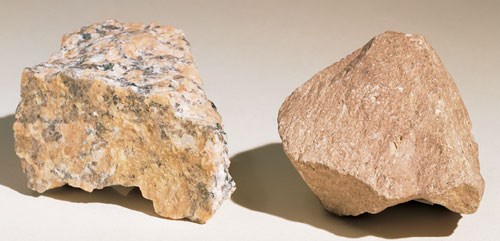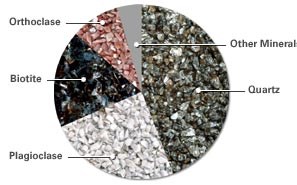Different Types of Rocks
There are three classifications of rocks:
- Igneous
- Metamorphic
- Sedimentary
Igneous
Igneous rocks put simply are cooled molten rock. Magma is molten rock beneath the Earth's surface and due to the magma's slow cooling, intrusive igneous rocks form and are characterized by large crystals due to extended cooling time. An example of an intrusive rock is granite. Extrusive igneous rocks form when lava on the Earth's surface cools rapidly and small or no crystals form. Examples of extrusive rocks are basalt or obsidian.
Igneous rocks are common in BC and are often seen in the black basalt cliffs and rocks of nearby beaches. Basalt rocks are not hard to find but great examples of expansive coastlines are seen in East Sooke Park and Witty's Lagoon (Yorath, 2005).
Chunks of igneous rocks can also be carried long distances by glaciers and be deposited in locations where there are no other examples of igneous rock around; these are often seen as white grantite rocks that match nothing else on the beach and stick out like a sore thumb!

Granite is an intrusive rock (large crystals) shown on the left while Rhyolite is an extrusive rock shown on the right with small crystals.

You get different colours of granite depending on the chemical composition.
Sedimentary
There are three classifications of sedimentary rocks. Sedimentary rocks are fragments (or clasts) of other rocks compressed under pressure to form a new mix of rock such as shale, mudstone, sandstone, or conglomerate. Sedimentary rocks can also be chemical in nature, where saline solution evaporates to leave salt behind as halite or the skeletons of tiny marine animals are compressed to form into limestone (Mussieux and Nelson, 1998). The third type of sedimentary rock is of the organic class and coal falls under this classification. Examples include soft coal and Anthracite (hard coal).
Excellent examples of sandstone can be seen on the Gulf Islands (where pretty much everything is composed of sandstone) and leading all the way up to the Nanaimo region where there are stunning sculpted sandstone cliffs.
There is not too much for limestone (if any) on southern Vancouver Island, however there are whole mountain ranges on the north island made out of this rock resulting in some of the largest cave systems in the world up there. See the earthcaches such as the Vanishing River, Reappearing River, or the Eternal Fountain for more info.
Finally coal...a huge story for a whole other earthcache. Large deposits of coal were extensively mined near Nanaimo in the 20th century and even today it is still not hard to find coal in the region (it is not commercially viable to mine nor is the quality worthy of the effort). For more information on Coal, see the Nanaimo Coal Boom earthcache page.
Metamorphic
Metamorphic rocks can be considered a hybrid of igneous and sedimentary rocks. They are generally existing rocks that are compressed under immense heat and pressure to be partially melted but also have their chemical composition changed slightly. Due to the high level of compression and partial melting, these rocks are very hard and tough.
The Capital Region has two types of metamorphic rock, Wark Gneiss and Colquitz Gneiss (Yorath, 2005).
Wark Gneiss is foliated (finely banded), dark-colured rock and contains hornblende and plagioclase feldspar (Yorath, 2005) (see pie chart above). A good example of Wark Gneiss is nearby at the Confederation Fountain (Yorath, 2005) (see attached waypoint). When the rock was formed, intricate veins of white quartz were injected into the rock (Yorath, 2005). This rock was later smoothed out by a 2 km thick sheet of ice that scraped overhead (Yorath, 2005).
Colquitz Gneiss is an older metamorphic rock which contains biotite, quartz, and plagioclase. This results in light and dark coloured banding and a great location to see this is Cattle Point in Oak Bay (Yorath, 2005).
In amongst this gneiss are deposits of Marble, a metamorphosed form of limestone (Yorath, 2005).
Your task at the Royal BC Museum
Near the posted coordinates you will see pieces of rock on display with accomanying signage/plaquards.
- Mica Schist
- Sandstone
- Tufa / Tuffa
- Argilite
- Basalt
- Conglomerate
- Granite
- [[Mystery Rock]] - for you to find ;-)
To Log This Earthcache
Submit the answers to me through my geocaching.com profile (ideally with the new messenger in the top right) and NOT in your log. Any logs without an accompanying e-mail without answers will be deleted without warning.
Please refrain from posting pictures with your log that could give away answers. They help armchair loggers!
The answers to these questions are either at the cache site or on this cache page.
1.) Basalt -Tell me what is special about this specific sample of basalt on display. How does it differ from the basalt on local beaches?
2.) Granite - From the diagram in the cache page, what does the specimen of granite on display mostly contain?
3.) Mica -Do a quick Google search. How many planes of cleavage does Mica have and what is cleavage?
4.) Tufa - Which of the three rock types does Tufa fall under and what kind of environment would somebody find a sample of some?
5.) Sandstone/Conglomerate - What is the same and different between these two rocks?
6.) Argillite - It is a sedimentary rock. Was it formed from mud, silt or sand? Where was the sample on display found?
7.) There is an 8th rock on display with accompanying sign. What is it? Does it correspond to the three rock types listed on this page?
Please refrain from posting pictures with your log that could give away answers. They help armchair loggers!
References
Granite/Rhyolite Comparison [jpeg]. (2014, October 20). Retrieved from http://baughhds.weebly.com/6th-grade-science.html
Musieux, R., & Nelson, M. (1998). A Traveller's Guide to Geological Wonders in Alberta. Edmonton, AB: Provincial Museum of Alberta.
Yorath, C. (2005). The Geology of Southern Vancouver Island. Madeira Park, BC: Harbour Publishing
